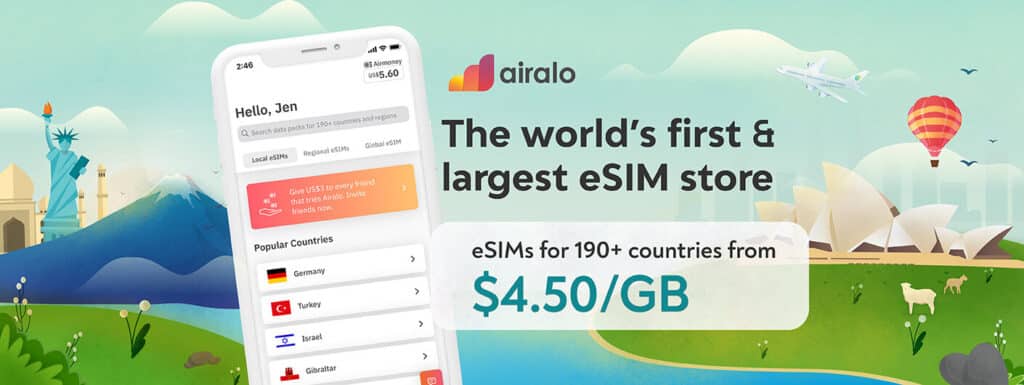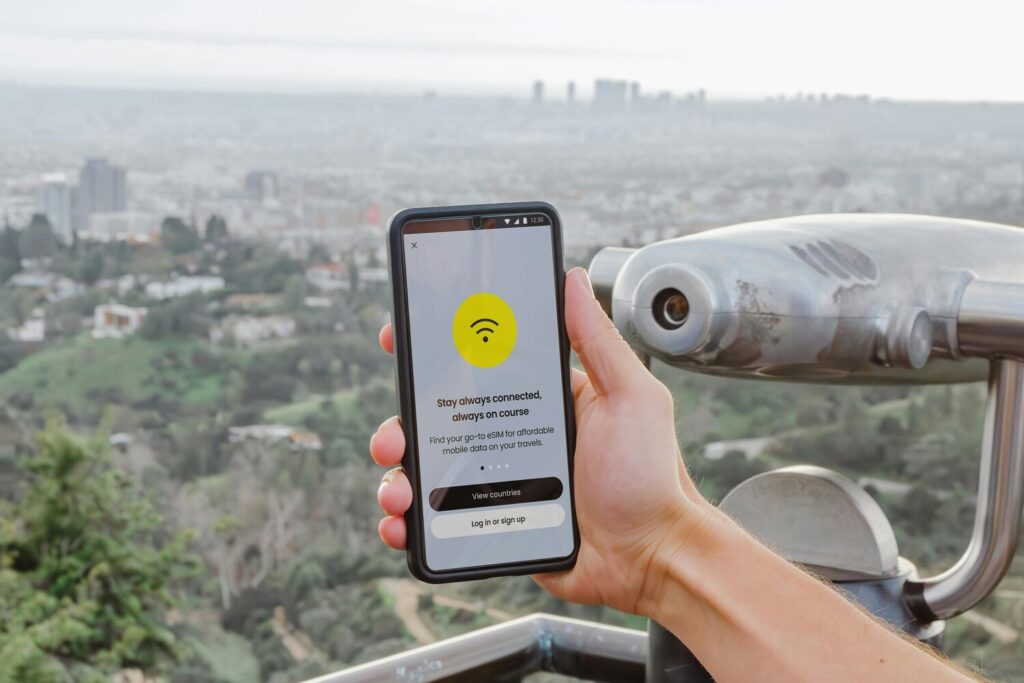
Verizon Review: The Best eSIM for Travel in 2025?
In today’s hyper-connected world, staying online while traveling isn’t a luxury anymore – it’s a necessity. Whether you’re a business traveler needing uninterrupted access, a digital nomad hopping between countries, or a budget-conscious explorer looking for affordable connectivity, choosing the right eSIM provider can make all the difference in terms of providing you with exactly what you need.
Verizon, a telecommunications powerhouse, has emerged as a strong contender in the international eSIM market, providing seamless global coverage, competitive pricing, and unlimited data options.
With service spanning over 220 countries and destinations, the primary aim behind Verizon is to simplify international connectivity by offering flexible plans tailored to different travel needs. Its TravelPass feature allows users to bring their existing unlimited data, talk, and text to over 210 countries, while it also has an International Monthly Plan that provides unlimited data with high-speed access for extended trips. But, with all this in mind, it’s still important to ask the big questions, including, does Verizon truly deliver on its promises?
So, in this review, we’ll explore Verizon’s eSIM offerings in depth – we’ll get into pricing, coverage, speed, ease of use, and all the pros and cons of its international plans. From its user-friendly activation process to its reliability in remote locations, we’ll assess whether Verizon stands out as the best eSIM provider for global travelers in 2025 or if there’s a better alternative waiting in the wings – because if there’s a better option, that’s where you want to be.
Without further ado, let’s dive in and find out whether or not Verizon is the ultimate solution for staying connected abroad and how it compares to its competitors.
Overview of Verizon
Verizon, one of the biggest and most successful telecommunications companies in the world, was founded in 2000 following the merger of Bell Atlantic and GTE. Headquartered in New York, Verizon is publicly traded and led by CEO Hans Vestberg.
Over the years, the brand has managed to build a reputation based on trust, consistently earning accolades for its network quality and innovation. Verizon has been recognized by J.D. Power for its wireless network quality multiple times and has received awards for sustainability, workplace excellence, and pretty impressive technological advancements.
In the eSIM market, Verizon competes with providers like Airalo, Nomad, and Holafly, which specialize in global and regional travel connectivity. But, while these competitors focus on affordability and flexibility, Verizon leverages its extensive infrastructure to provide premium service with strong reliability. Its eSIM offerings cater to international travelers who prioritize seamless connectivity, high-speed data, and a trusted network.
One of the Verizon’s key selling points is its ability to integrate eSIM technology with its robust 4G and 5G networks, ensuring consistent performance across a vast number of countries all around the world.
Key Features at a Glance
Coverage: Over 220 countries and destinations
Network: 4G LTE and 5G Ultra Wideband availability
Pricing: Competitive, with premium options for high-speed access
App Usability: Easy setup via the My Verizon app, with seamless recharge options
Activation: Instant activation through QR code or manual setup via the app6
Verizon’s eSIM solutions are designed for travelers who need reliable, high-speed connectivity without the hassle of physical SIM cards, because honestly, having to fiddle around with tiny sim cards is a thing of the past (as it should be). With its strong global presence, competitive pricing, and user-friendly activation process, Verizon continues to be a top choice for international connectivity.
Coverage and Network Reliability
Verizon offers extensive global coverage, and when they extensive they really mean it – we’re talking over 220 countries and destinations. Its international plans, including TravelPass and the International Monthly Plan, allow users to stay connected in most major regions. But, it’s a good idea to be aware that some remote areas may have limited service, and certain countries may not be included in its coverage map, so bear this in mind when you’re planning your trip.
Now, Verizon partners with various local carriers to provide reliable service worldwide. In Europe, it collaborates with major providers like Orange and Deutsche Telekom to ensure strong connectivity. In North America, Verizon operates on its own network, offering widespread 4G LTE and 5G Ultra Wideband coverage.
Across Asia, it works with carriers such as NTT Docomo in Japan and Airtel in India to maintain consistent service. While Verizon generally provides 4G and 5G access in supported regions, network availability can vary depending on local infrastructure and roaming agreements.
Performance by Region
Europe: Users traveling through Europe have reported excellent speeds, especially in France and Germany, where Verizon partners with Orange and Deutsche Telekom. Roaming is generally smooth, but some rural areas may experience occasional slowdowns, which is pretty common.
North America: Verizon’s coverage is strong in urban areas, with reliable 5G access in major cities, but rural regions may still rely on 4G LTE, and some remote locations may have weaker signals.
Asia: Verizon offers connectivity in key countries like China, Japan, and India, but service quality can depend on local carrier agreements. In highly developed areas, speeds are generally fast, while more remote locations may have limited access.
South America and Africa: Coverage in South America and Africa can be more inconsistent. While Verizon provides service in many countries, speeds may drop significantly in rural or less-developed regions. Users traveling to these areas should check local carrier support before relying on Verizon’s eSIM for primary connectivity.
Overall, Verizon’s international eSIM service is a solid choice for travelers who need reliable coverage in most major destinations, though performance can vary based on location and network partnerships, so have a closer look if you’re going somewhere kind of remote.
Data Plans and Pricing
Verizon offers a range of eSIM plans designed to suit different types of travelers, whether you need a short-term data package or a more comprehensive global plan. Options include pay-as-you-go plans, unlimited data packages, and regional or global bundles, giving users flexibility based on their travel needs – you’re pretty much guaranteed to find what you need no matter what you’re looking for.
Pricing varies depending on the plan, with the most affordable option starting at around $5 for 1GB of data, while unlimited plans can go up to $99 per month if you’re happy to spend some bucks.
Verizon occasionally offers discounts for long-term users, especially those who enroll in auto-pay or bundle their eSIM with other Verizon services. Compared to competitors like Airalo, Nomad, and Holafly, Verizon tends to be on the premium side, offering strong network reliability and high-speed access, but it’s going to cost you. While Airalo and Nomad focus on affordability, Verizon’s plans often provide better coverage and faster speeds, making it a solid choice for travelers who prioritize performance over cost.
Hidden fees can be a concern with any eSIM provider, and unfortunately, Verizon is no exception. Some plans may have data expiration policies, meaning unused data doesn’t roll over. Also, hotspot and tethering features might come with extra charges or limitations, depending on the plan. It’s always a good idea to check the fine print before committing to a package.
| Data Plan | Price | Validty | Coverage |
| 1GB | $5 | 7 Days | Global |
| 5GB | $15 | 30 Days | Global |
| 10GB | $27 | 60 Days | Global |
| Unlimited | $19 | 30 Days | Selected regions |
Internet Speed and Network Performance
Verizon’s internet speed and network performance are generally solid, but like any provider, it has its ups and downs – frustrating, but kind of hard to avoid. Speed tests show that Verizon delivers impressive speeds in major regions, with 5G Ultra Wideband reaching well over 1 Gbps in optimal conditions.
But, in some areas, users report that Verizon’s 5G is more like high-speed 4G, especially when outside major cities. While the network is expanding, coverage can vary depending on location.
Latency is a big deal for streaming, gaming, and video calls, and Verizon performs well in most cases. Gamers generally find the connection stable, but some users have reported lag spikes when playing competitive online games, especially on Verizon’s 5G Home Internet.
For streaming, Verizon holds up well, with low latency ensuring smooth playback, though some users have noticed delays when watching live events. Video calls are usually reliable, but congestion during peak hours can sometimes cause minor disruptions.
Real-world user feedback is mixed when it comes to speed consistency, making things a bit tough. Many users praise Verizon’s reliability, but others complain about noticeable slowdowns during peak times, especially on Friday nights. Some customers have reported that speeds drop significantly in congested areas, even on premium plans.
While Verizon’s network is strong overall, it’s worth checking local coverage and peak-time performance before relying on it for high-speed connectivity. If you need consistently fast speeds, it might be worth considering alternative providers in certain regions, especially super busy places like busy cities with high population density.
Ease of Use and Setup Process
Getting started with Verizon’s eSIM is refreshingly simple. First, you buy a plan through the Verizon website or the My Verizon app. Once you’ve selected your plan, Verizon provides a QR code for activation.
If you’re using an iPhone or Android device, you just scan the code in your phone’s settings under “Cellular” or “Mobile Network,” and boom, just like that, you’re connected. No fiddling with tiny SIM cards or waiting for shipping. The app walks you through the process step by step, making it easy even for those who aren’t tech-savvy.
The My Verizon app itself is pretty user-friendly. You can check your balance, top up your data, and switch plans with just a few taps. The interface is clean, and everything is laid out logically, so you’re not digging through endless menus to find what you need. Plus, the app lets you manage multiple lines if you’re traveling with family or juggling work and personal numbers.
Customer support is available through multiple channels, including live chat, email, and phone support. Verizon’s support team is generally responsive, but wait times can vary depending on the time of day. While they offer 24/7 assistance for most issues, some users have reported longer response times during peak hours. If you run into trouble, the live chat option is usually the fastest way to get help. Overall, Verizon makes the eSIM experience smooth and hassle-free, which is exactly what you want when traveling.
Pros and Cons of Verizon
Here’s a super quick and easy breakdown of Verizon’s main pros and cons:
✅ Pros:
✔ Affordable pricing for short-term travelers, making it a great option for those on quick trips.
✔ Strong coverage in over 220 countries, ensuring reliable connectivity in most major destinations.
✔ Easy activation with QR codes, allowing users to set up their eSIM in minutes without hassle. ✔ No need to swap physical SIM cards, so it’s nice and convenient for frequent travelers.
❌ Cons:
❌ No true unlimited data plans, which could potentially be a downside for heavy users who need constant high-speed access.
❌ Slower speeds in certain regions, especially in rural areas or places with weaker network infrastructure.
❌ Limited customer support hours, meaning assistance may not always be available when traveling in different time zones.
Ultimately, Verizon’s eSIM service is a solid choice for travelers who want reliable connectivity and easy setup, but it’s worth considering these limitations before making a decision.
Who Should Use Verizon?
At the end of the day, some eSIM providers are just going to be more suitable than others for specific people. Here’s a quick snapshot of who we think is best of using Verizon and who should probably look elsewhere.
✅ Ideal For:
✔ Digital nomads who bounce between countries and need a reliable connection without swapping SIM cards.
✔ Short-term travelers looking for an easy, affordable way to stay connected without committing to long-term contracts.
✔ Business travelers who require strong coverage and fast speeds in multiple locations to keep up with work while they’re on the go.
❌ Not Ideal For:
❌ Travelers who need truly unlimited data – Verizon’s plans have limits, and heavy users might find themselves running out.
❌ Those visiting remote areas with weak connectivity – while Verizon has great coverage, some rural or less-developed regions may experience slower speeds.
❌ People who rely on 24/7 customer support. Verizon’s assistance is solid, sure, but response times can vary, and support isn’t always instant.
Verizon’s eSIM is a great choice for most travelers, but if you need unlimited data or plan to venture far off the beaten path, you might want to explore other options.
How Does Verizon Compare to Competitors?
| Feature | Verizon | Airalo | Holafly | Nomad |
| Coverage | 150+ Countries | 200+ Countries | 100+ Countries | 130+ Countries |
| Pricing | $$ | $ | $$$ | $$ |
| Speed | 4G/5G | 4G | 4G | 4G/5G |
| App Experience | ⭐⭐⭐⭐ | ⭐⭐⭐⭐ | ⭐⭐⭐ | ⭐⭐⭐⭐⭐ |
| Best For | Budget travelers | Global use | Unlimited data | Regional plans |
Verizon really does hold its own in the eSIM market, offering strong coverage and reliable speeds, especially with its 5G Ultra Wideband network. While Airalo is the go-to for global coverage at budget-friendly prices, Holafly stands out for unlimited data plans, and Nomad is great for regional connectivity. Verizon is best suited for budget-conscious travelers who want a balance between affordability and performance.
If you’re a short-term traveler looking for a quick and easy eSIM, Verizon is a solid choice. But, if you need unlimited data, Holafly might be a better fit. For those hopping between multiple countries, Airalo’s extensive coverage could be more appealing. And, if you’re traveling within a specific region, Nomad’s plans might offer better value. Ultimately, the best eSIM provider depends on your travel style and connectivity needs.
Final Verdict: Is Verizon Worth It?
Verizon’s eSIM service is a solid option for travelers who want reliable connectivity without the hassle of physical SIM cards. Its best features include strong coverage in over 220 countries, easy activation via QR codes, and a user-friendly app that makes managing data simple.
The network’s 4G and 5G speeds are generally fast, especially in urban areas, making it a great choice for business travelers and digital nomads who need consistent performance.
That said, it’s still not perfect. Verizon’s pricing is on the premium side, and while it offers competitive rates, it doesn’t always have the cheapest plans compared to providers like Airalo or Nomad. Unlimited data isn’t always an option, unfortunately, and speeds can drop in certain regions, particularly in rural areas or places with weaker infrastructure. Customer support is reliable but not always available 24/7, which could be frustrating if you run into issues while traveling.
Is it worth the price? Honestly, if you value strong coverage, easy setup, and reliable speeds, then yes – Verizon is a great choice. It’s best suited for short-term travelers, business professionals, and digital nomads who need dependable connectivity.
But, if you’re looking for unlimited data or the absolute lowest prices, competitors like Holafly or Airalo might be better suited. Overall, at the end of the day, Verizon’s eSIM is a solid pick, and we’d recommend it for most travelers who want a hassle-free experience.








Responses